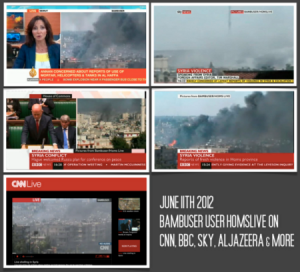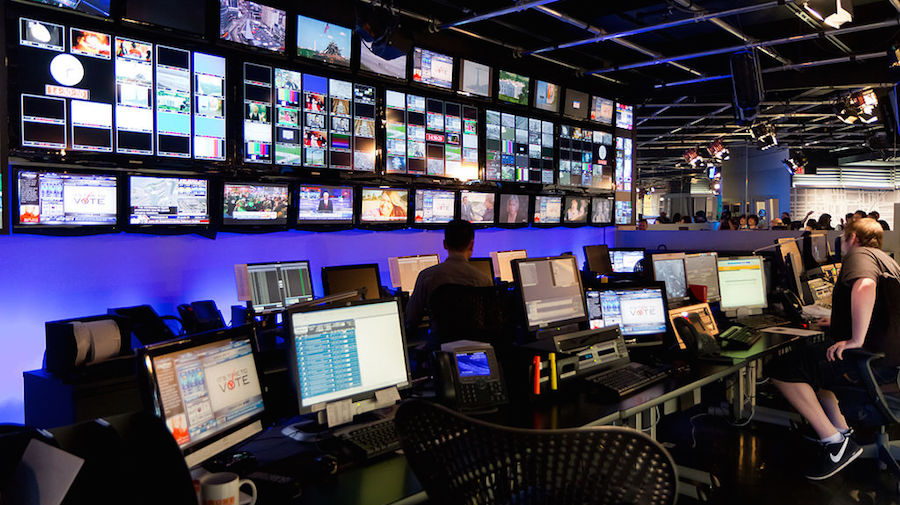Now that Facebook and Twitter (with Periscope) give their users the ability to live stream video from their mobile devices news organisations will — and have indeed already started to — see a growing trend in this type of content being produced in breaking news situations.
This different type of eyewitness media must still be treated with the same caution given to all, however, and will still only be of real value to audiences if journalists are able to verify and add the necessary context.
The major social platforms may have only just got in on the act, but it is worth remembering that livestreaming among the public has been around for several years, so some valuable lessons have already been learned about its verification and accompanying ethical considerations.
Bambuser was one of the first platforms to give users the opportunity to broadcast live video. During the first protests in Syria and the early days of the civil war a large community of streamers was established. Those activists live streamed the shelling of many of Syria’s main cities, perhaps most notably the initial siege on Homs.
Syrian activists used Bambuser to stream live video in the early days of the civil war. This content was frequently used by broadcasters.
The most important lessons learned during those live streams were the impact that live streaming from a specific location could have on an individual’s safety. The streamers were often targeted by opposition forces if their location was too obvious. Eventually many individuals left cameras to livestream from rooftops or other static positions unmanned.

Infographic courtesy of Bambuser
Watching an event unfold live, often from a number of angles in places with clearly recognisable landmarks means you can verify the content quickly enough to broadcast it live. As many did.
At the height of the tensions in Ferguson, Missouri, in August 2014, many protesters turned to the live streaming app Ustream, often capturing hours of video in one go. In one notable incident an officer was suspended for appearing to threaten the media with a weapon during one such live stream.
Now that live streaming is inextricably linked to social distribution, there are a few questions that many will need answered.
How do you verify live video?
It is almost easier and certainly less time-consuming than to verify video beamed live than clips uploaded after the fact because a lot of the hardest parts of verification relate to determining the time and location of a piece of content. A geo-tagged live stream gets around that issue very quickly, especially if you have other sources confirming an event is ongoing.
For obvious reasons it is also harder to fake live video, so there is less chance of something being altered or even misrepresented.
Communication with content creators is always key to verification and when it comes to live streams there are clear advantages, but also challenges.
For example, most of the live-streaming platforms allow you to interact with users as they broadcast (whether they are in a position to respond is another thing) and since they are linked to social accounts you can also message them afterwards.
But that user is much more likely to respond if they see the message while the device is still in their hand, as once the event is over it could be some time before they check their device again. And, if your message was lost in a stream of other messages it might never get noticed.
What do I need to get verified live video to the audience (with context)?
All of the platforms offering livestreaming opportunities allow you to embed both the live and/or replay-able versions of the videos. This is where important verification information for the audience can and should be given in an online environment.
Broadcasting one of the social streams is still going to be a little tricky, and if you are a broadcaster you will probably need to use something like a scan convertor, which allows you to capture a computer screen in real-time, in your control room for the time being. Also, as with things like Vine and Instagram videos the vertical video format is not always going to look pretty on 16:9 output.
Unlike other live-video technology that traditional broadcasters have used for decades there is no way to set a delay on a live stream. When a bomb blast rocked central Bangkok in August 2015 and Periscope users were some of the first on the scene, graphic scenes were relayed live for people to see. Broadcasters will still have the ability to set a delay but for those embedding this is a very important consideration.
How do we keep live-streamers safe?
Always think about their safety in real-time and how it relates to unfolding events. For example:
- Are they filming something that someone may wish to stop?
- Could the party wishing to stop the streaming identify the individual and/or their location and use that information to cause harm?
- Could using the live-stream on a news broadcast or platform change the nature of the event in a way that puts the streamer in danger?
- Does the use of the content or your communication with the person creating it encourage or give them an incentive to take an unnecessary risk?
- They are likely untrained in media law, so if they capture something with strong legal concerns, does the live broadcast of that content (assuming you have no kill switch or delay) have the potential to cause them to break the law?
The fact the technology now makes starting a broadcast as easy as reaching into a pocket will undoubtedly mean more newsworthy material is available to newsrooms as a story breaks. But that immediacy makes the need to use such material responsibly even greater.



